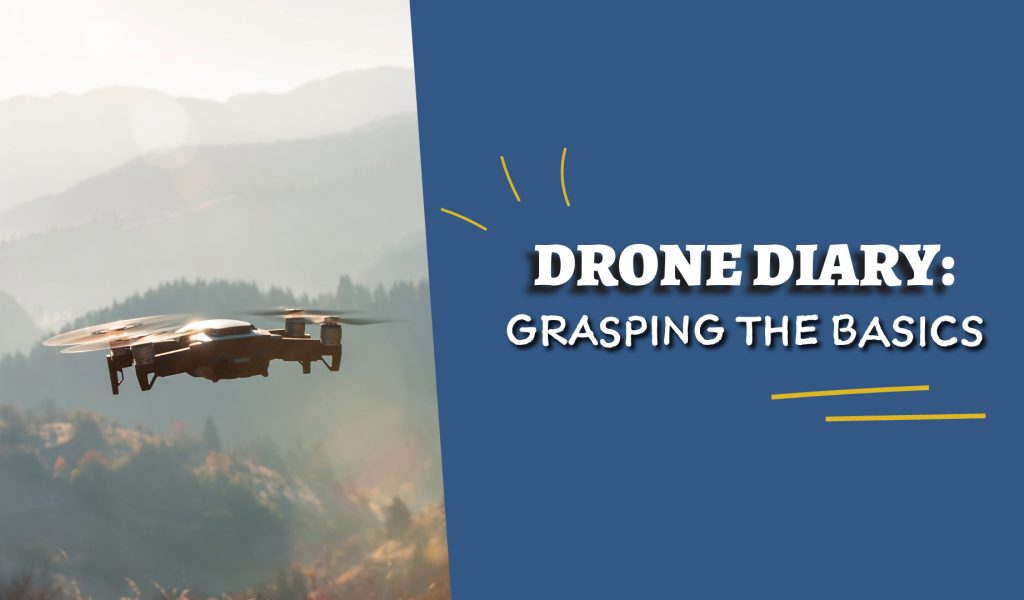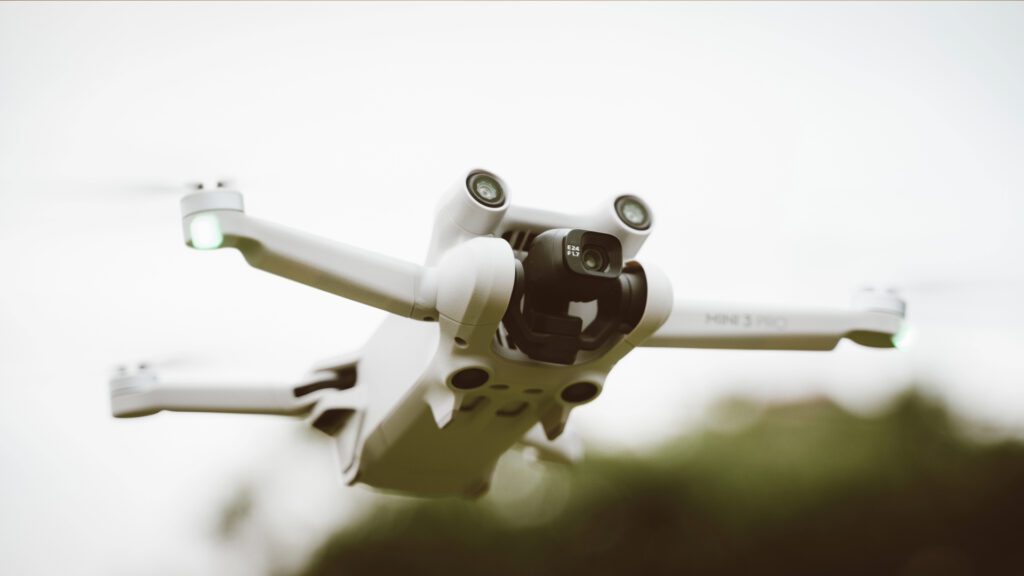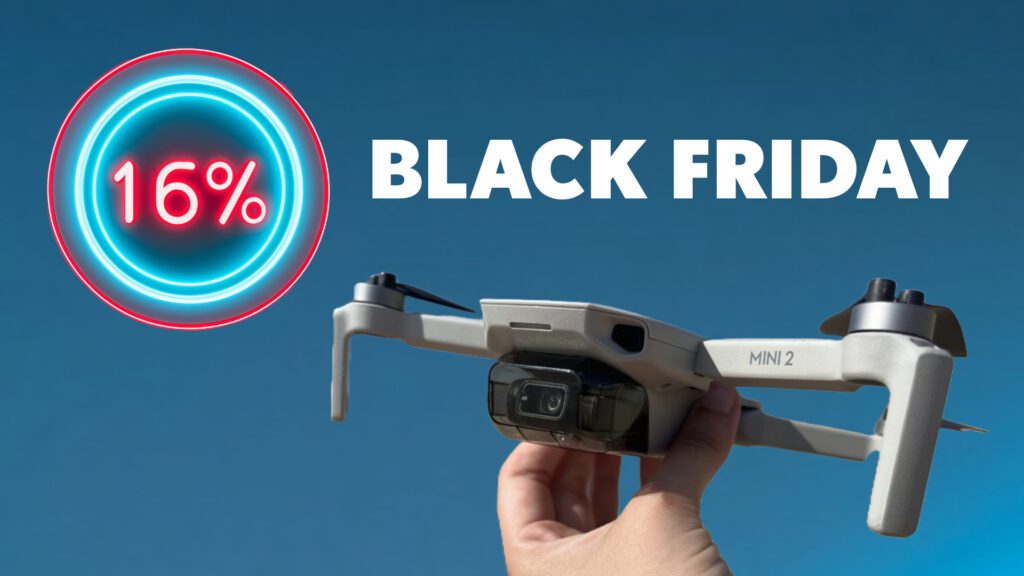We got our DJI Mini 2 in Dec 2021. And after doing that tempting move that probably most people do with a new drone is test it inside. It was night so I wasn’t risking taking it outside but I sure wasn’t going to wait until morning to play with a new toy.
Not sure if everyone gets the same feeling when they first test out their drone… A swarm of about 10,000 bees at once. The drone camera looks cool on my phone… Now, that’s enough for one day!
We took it out for a few flights in January, at our local park. But the fear was real. Do we drone here? No this is in the middle of a path. What about here? No there’s a group of dog walkers on the way. Okay, here in this cut-off field. And lift off!! And… someone’s coming this way.
Although not an issue so much now, back then we were cautious to pause our drone every time someone approached.
Once up in the air, I was greeted with flashbacks of driving my remote control car as a kid. Only this was in the air and I was LOVING it.
Learning the ropes
Now fast forward to two years on and we’ve been droning a lot these past few months. Surprisingly, the weather in Northern England has been perfect for it. We’ve explored Merseyside and the Lakes to practice capturing footage.
Playing around with the intelligent flight controls has been exciting. Figuring out the features and watching yourself become a spec on your drone’s eye. Although I must admit, it gets nerve-wracking to see the drone doing a circle orbiting shot, knowing it’s getting a little too close to comfort with trees as such in its flight path.
One thing we quickly realised is that we needed to buy an extra battery. Even though 31 minutes may sound like enough flight time on paper, it’s nowhere near once you’re out flying. Especially when you take into account, the extra time for connecting the drone and remote controller, attaching appropriate filters, and adjusting exposure settings if needed. Also, if you decide there’s a cool shot you want to do but know that you shouldn’t on less than 20% battery.
We started getting up early to go and drone our local church. We had the privilege of being able to drone before 8am during the week, so the town was pretty quiet and any passersby thought it far too early to question why there was a couple droning a church.
From those flights, I put together some neat clips to create a mini video with the help of Premier Pro. It had cool shots of the church, like revealing it from the ground up by flying upwards, orbiting a nearby statue, panning out of the trees, and capturing an aerial view of the surroundings.
It wasn’t anything too fancy, but definitely better than just a bunch of random clips.
We got the hang of the flying modes pretty quickly, especially in the spacious park. My partner couldn’t resist trying out Sport mode early on and had a blast pulling off infinity eights and 180s in the air. But, well, too much speed and excitement led to our first crash landing—into a tree!
Thankfully, we figured out the ‘Find My Drone’ feature in our settings, a lesson in itself. Although nicely cushioned by leaves and nettles, we rescued it without any damage to ourselves or the drone.
Maybe we should stick to normal mode for a bit?
Flying over water
The beauty of the Lakes is undeniable. But seeing the views from the sky is something else.
Going back home to visit family for a few days, we thought it best to use the opportunity to grab some shots of Lake Ullswater and Lake Windermere.
We also decided to drone Castle Park in Penrith. But as this was before we got ND filters, and the day was pretty overcast, the images unfortunately turned out a bit colourless and almost artificial-looking.
Lake Windermere, on the other hand, gave us some fantastic shots as we got a friend to paddleboard. It was a brilliant chance to experiment with droning a moving subject. Circling a moving object manually while keeping it centred in the frame is quite challenging at first, but the results are amazing when you get the hang of it.
This was one of the first times we flew the drone over water, but I felt confident enough to launch it from the paddleboard. I was a bit nervous about catching it – since the floor was water – so we made sure to get back to shore swiftly to land the drone.
Looking back, I think that with more experience, I would’ve had the confidence to hand-launch and land the drone on the paddleboard too. It’s a skill worth mastering if you plan on flying over water frequently.
And I must say, my editing skills were improving at this point. With minor touch-ups, I was able to make the water appear more vibrant and blue, whilst making the paddleboard subject stand out against the backdrop.
Trust the app
When the weather was starting to get really nice and warm (and stable), we decided to venture out a bit further to Formby Beach and Otterspool in Merseyside.
This is where encountered some chaotic fun!
At Otterspool, looking at the DJI Fly app, we were in a warning zone and an authorisation zone. At first glance, I thought take-off wouldn’t be an option.
But following the instructions on the app, we had to ‘unlock’ the area, which meant we had to put in a few details so our drone was authorised to fly in this area. We also had to keep below 120m which wasn’t a problem as we were just grabbing a few shots over the promenade.
We were still quite new to geo zones so weren’t sure how flexible each restriction was.
Then, our journey got even more exciting in Formby. We knew there was a red warning zone covering most of the area. But we thought as the geo zone looked familiar to the other site, we could’ve unlocked the drone for take-off.
We also weren’t directly on the beach. This was not the case.
Turns out, most of Formby Beach is a completely locked area for take-off under National Trust restrictions. However, I knew from doing my research prior that although takeoff was forbidden, taking off outside and droning in the area isn’t a problem.
Using the map we had to navigate down to a corner of the beach that was just in between the intercepting red zones and we could unlock the drone for take off.
Luckily a walk along the beach under the sun is see as more a seldom luxury in Britain.
We grabbed a few nice shots here using an ND filter to reduce the glare of the sun on the water. We caught the sand dunes, the boats, and the town of Formby behind.
Oh, but wait… problems weren’t over just yet. I was so used to the controller charging my phone, I didn’t think twice when my phone was now at 10% battery. My phone died.
LUCKILY the app and everything was already set up on my partner’s phone so we could quickly hook it up before anyone started to hear a fast-descending buzzing noise.
From this experience however, I learned that Apple phones do a way better job at handling the brightness of the day sun. A problem I’m not sure is familiar to Android drone users, but one to be aware of under bright sun.
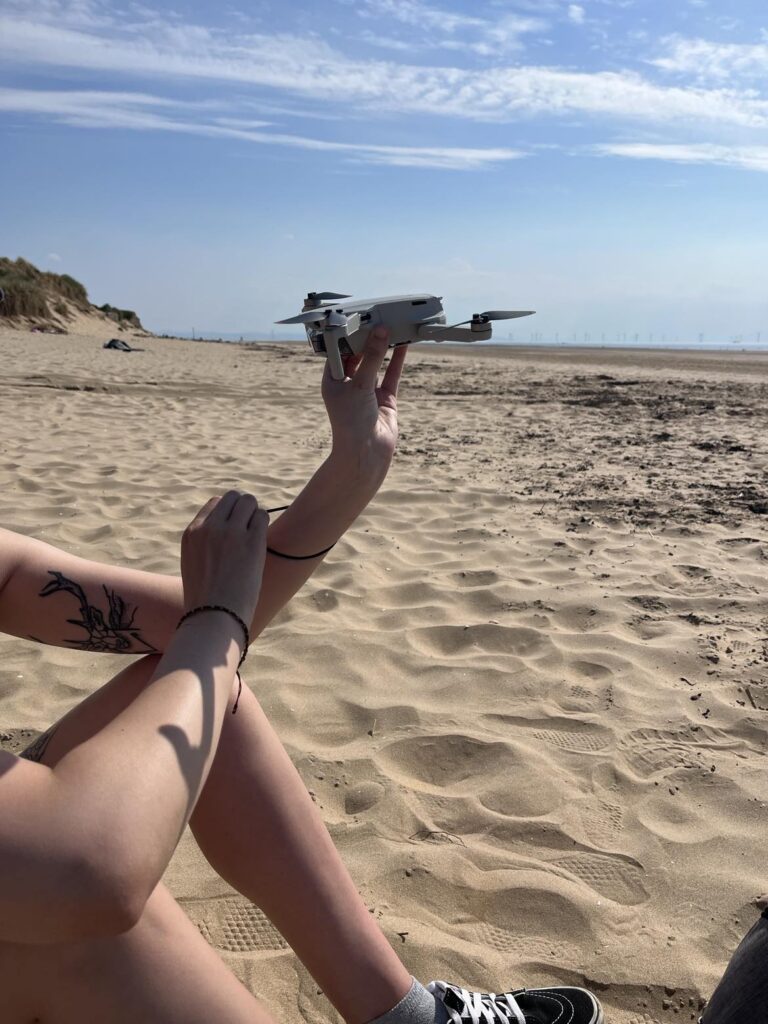
Near miss… oh wait
Williamson Park in Lancaster was some of the best footage we’ve captured so far!
Even without filters, we managed to capture some killer shots with the sun high in the sky. I didn’t really plan for the shots beforehand on this one, but since I’d done a few similar flights beforehand, the ideas started flowing.
Orbiting shot? Check. Revealing shot? Check. Aerial shot above the spire? Double-check. We even flew the drone up the symmetrical staircase, and it all came together beautifully in one epic clip.
This park was full of people too. But good company can rid you of most fears.
I wanted to grab a last dronie shot before we left. I wanted to get us all together on the stairs, and then the drone would fly backwards, revealing the scene behind us. I’ll do it manually so it’s more careful, I thought. Seemed like a great plan.
But guess what? Our drone ended up in a tree… again.
Fear hit me first, followed by a mix of stupidity and embarrassment. Luckily, the whole clip was recorded, so it can be brought up again for a good laugh. Thankfully, the drone didn’t suffer any major damage, just a snapped propeller that we quickly replaced.
Briefly after, I got back on the horse and tried again. This time, I made sure to steer clear of the trees, and voilà, I got an even better shot in the end.
Taking it to the next level
This is where we took a big step in taking the drone international. We had a booked holiday for Tenerife for a couple of days, and getting a hotel close to the beach meant we could get down there once the boardwalk was quiet and get some shots in.
Though a little daunting to be outside of UK regulations and travelling with valuable items, the shots were postcard-worthy.
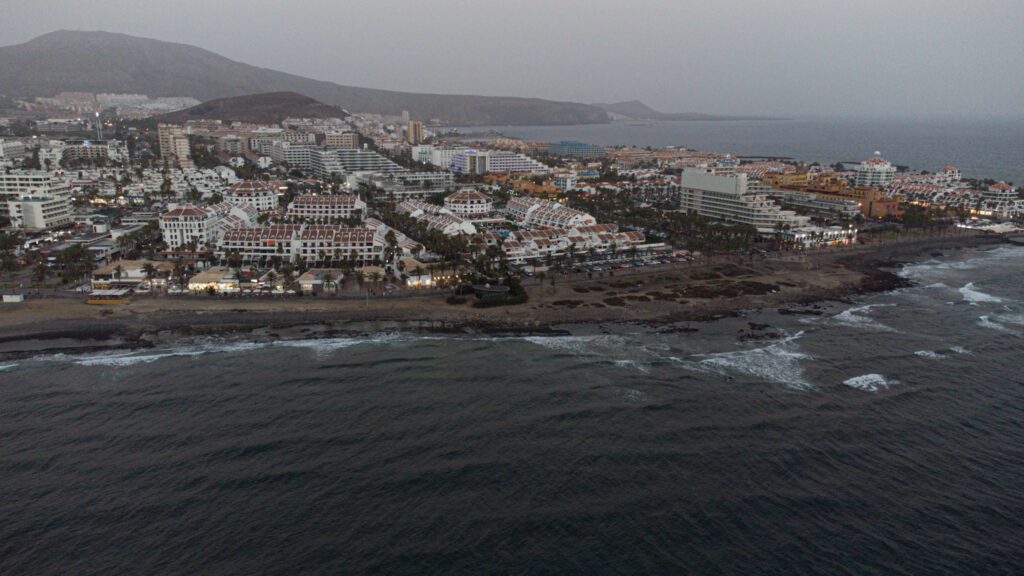
Having done quite a few water shots, I was familiar with pulling off the backdrop revealing shot, the mountains behind and some cinematic orbits. The dronie shot was also easier to pull off with more open airspace.
It was about an hour after sunset. Unfortunately, we forgot to bring the filters so there was a lot of fiddling with the ISO settings, which resulted in some shots looking more grainy than others.
Nonetheless, the shots turned out better than I thought and I still get a little amazed when you see shots that you’ve personally taken.
I’d love and hope to get some more shots abroad in the next coming months. Maybe Europe or even Asia.
Lessons learned so far
A lot has happened in four months now I see it written down. Two crashes. Plenty of fear. But lots of lessons were learned and skills developed.
I’m getting more confident in my video and photo editing skills. And flying the drone has become more muscle memory. And most importantly, our confidence is growing in taking the drone out to different places.
Lesson #1
Always take ND filters. They work great on cloudy days, sunny days and evening shots. Depending on what you want of them, they can block glare, increasing the shutter speed without affecting the ISO. And they can really help the quality of the shots without too much input from you.
A lot of shots I’ve taken when tend to be colourless skies or with glare. I wasn’t using filters on the drone’s lens so a lot of the shots tend to have bland white skies which is difficult to find post-production. Go out at the right time of day, with the appropriate accessories and you can minimise the grunt work later.
Lesson #2
Don’t always trust intelligent controls. They work fine when you’re getting used to flying. But I find it better to try to practice these manually. That way you have more control and flexibility over your shots wherever you shoot.
You can also manually stop the drone whenever you feel a risk and you’re not waiting on the stop button if anything goes wrong.
Lesson #3
People really aren’t that bothered. The fear of taking your drone out for the first time is daunting – I won’t lie!
I know it because we wrote an article on tips to handle drone anxiety.
But people don’t really care. Especially if you’re with someone, no one really is going to tell you you can’t do that here. Well, they can. But as a public member and probably not someone who knows a lot about drones, they don’t control the airspace and probably know much less about the regulations than you do.
So long as you’re not a nuisance or a disturbance, people tend to leave you alone.

